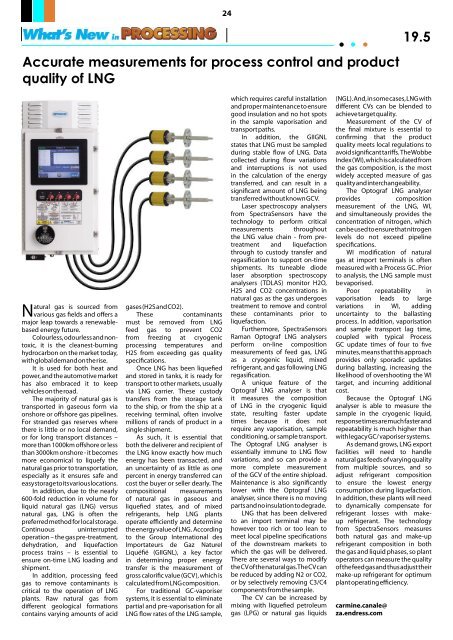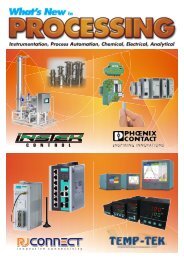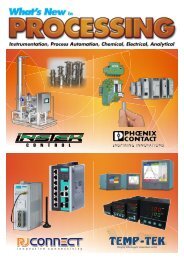WNIP SEPT OCT 19.5 DIGITAL
You also want an ePaper? Increase the reach of your titles
YUMPU automatically turns print PDFs into web optimized ePapers that Google loves.
24<br />
<strong>19.5</strong><br />
Accurate measurements for process control and product<br />
quality of LNG<br />
Natural gas is sourced from<br />
various gas fields and offers a<br />
major leap towards a renewablebased<br />
energy future.<br />
Colourless, odourless and nontoxic,<br />
it is the cleanest-burning<br />
hydrocarbon on the market today,<br />
with global demand on the rise.<br />
It is used for both heat and<br />
power, and the automotive market<br />
has also embraced it to keep<br />
vehicles on the road.<br />
The majority of natural gas is<br />
transported in gaseous form via<br />
onshore or offshore gas pipelines.<br />
For stranded gas reserves where<br />
there is little or no local demand,<br />
or for long transport distances –<br />
more than 1000km offshore or less<br />
than 3000km onshore - it becomes<br />
more economical to liquefy the<br />
natural gas prior to transportation,<br />
especially as it ensures safe and<br />
easy storage to its various locations.<br />
In addition, due to the nearly<br />
600-fold reduction in volume for<br />
liquid natural gas (LNG) versus<br />
natural gas, LNG is often the<br />
preferred method for local storage.<br />
Continuous uninterrupted<br />
operation – the gas pre-treatment,<br />
dehydration, and liquefaction<br />
process trains – is essential to<br />
ensure on-time LNG loading and<br />
shipment.<br />
In addition, processing feed<br />
gas to remove contaminants is<br />
critical to the operation of LNG<br />
plants. Raw natural gas from<br />
different geological formations<br />
contains varying amounts of acid<br />
gases (H2S and CO2).<br />
These<br />
contaminants<br />
must be removed from LNG<br />
feed gas to prevent CO2<br />
from freezing at cryogenic<br />
processing temperatures and<br />
H2S from exceeding gas quality<br />
specifications.<br />
Once LNG has been liquefied<br />
and stored in tanks, it is ready for<br />
transport to other markets, usually<br />
via LNG carrier. These custody<br />
transfers from the storage tank<br />
to the ship, or from the ship at a<br />
receiving terminal, often involve<br />
millions of rands of product in a<br />
single shipment.<br />
As such, it is essential that<br />
both the deliverer and recipient of<br />
the LNG know exactly how much<br />
energy has been transacted, and<br />
an uncertainty of as little as one<br />
percent in energy transferred can<br />
cost the buyer or seller dearly. The<br />
compositional measurements<br />
of natural gas in gaseous and<br />
liquefied states, and of mixed<br />
refrigerants, help LNG plants<br />
operate efficiently and determine<br />
the energy value of LNG. According<br />
to the Group International des<br />
Importateurs de Gaz Naturel<br />
Liquéfié (GIIGNL), a key factor<br />
in determining proper energy<br />
transfer is the measurement of<br />
gross calorific value (GCV), which is<br />
calculated from LNG composition.<br />
For traditional GC-vaporiser<br />
systems, it is essential to eliminate<br />
partial and pre-vaporisation for all<br />
LNG flow rates of the LNG sample,<br />
which requires careful installation<br />
and proper maintenance to ensure<br />
good insulation and no hot spots<br />
in the sample vaporisation and<br />
transport paths.<br />
In addition, the GIIGNL<br />
states that LNG must be sampled<br />
during stable flow of LNG. Data<br />
collected during flow variations<br />
and interruptions is not used<br />
in the calculation of the energy<br />
transferred, and can result in a<br />
significant amount of LNG being<br />
transferred without known GCV.<br />
Laser spectroscopy analysers<br />
from SpectraSensors have the<br />
technology to perform critical<br />
measurements throughout<br />
the LNG value chain - from pretreatment<br />
and liquefaction<br />
through to custody transfer and<br />
regasification to support on-time<br />
shipments. Its tuneable diode<br />
laser absorption spectroscopy<br />
analysers (TDLAS) monitor H2O,<br />
H2S and CO2 concentrations in<br />
natural gas as the gas undergoes<br />
treatment to remove and control<br />
these contaminants prior to<br />
liquefaction.<br />
Furthermore, SpectraSensors<br />
Raman Optograf LNG analysers<br />
perform on-line composition<br />
measurements of feed gas, LNG<br />
as a cryogenic liquid, mixed<br />
refrigerant, and gas following LNG<br />
regasification.<br />
A unique feature of the<br />
Optograf LNG analyser is that<br />
it measures the composition<br />
of LNG in the cryogenic liquid<br />
state, resulting faster update<br />
times because it does not<br />
require any vaporisation, sample<br />
conditioning, or sample transport.<br />
The Optograf LNG analyser is<br />
essentially immune to LNG flow<br />
variations, and so can provide a<br />
more complete measurement<br />
of the GCV of the entire shipload.<br />
Maintenance is also significantly<br />
lower with the Optograf LNG<br />
analyser, since there is no moving<br />
parts and no insulation to degrade.<br />
LNG that has been delivered<br />
to an import terminal may be<br />
however too rich or too lean to<br />
meet local pipeline specifications<br />
of the downstream markets to<br />
which the gas will be delivered.<br />
There are several ways to modify<br />
the CV of the natural gas. The CV can<br />
be reduced by adding N2 or CO2,<br />
or by selectively removing C3/C4<br />
components from the sample.<br />
The CV can be increased by<br />
mixing with liquefied petroleum<br />
gas (LPG) or natural gas liquids<br />
(NGL). And, in some cases, LNG with<br />
different CVs can be blended to<br />
achieve target quality.<br />
Measurement of the CV of<br />
the final mixture is essential to<br />
confirming that the product<br />
quality meets local regulations to<br />
avoid significant tariffs. The Wobbe<br />
Index (WI), which is calculated from<br />
the gas composition, is the most<br />
widely accepted measure of gas<br />
quality and interchangeability.<br />
The Optograf LNG analyser<br />
provides<br />
composition<br />
measurement of the LNG, WI,<br />
and simultaneously provides the<br />
concentration of nitrogen, which<br />
can be used to ensure that nitrogen<br />
levels do not exceed pipeline<br />
specifications.<br />
WI modification of natural<br />
gas at import terminals is often<br />
measured with a Process GC. Prior<br />
to analysis, the LNG sample must<br />
be vaporised.<br />
Poor repeatability in<br />
vaporisation leads to large<br />
variations in WI, adding<br />
uncertainty to the ballasting<br />
process. In addition, vaporisation<br />
and sample transport lag time,<br />
coupled with typical Process<br />
GC update times of four to five<br />
minutes, means that this approach<br />
provides only sporadic updates<br />
during ballasting, increasing the<br />
likelihood of overshooting the WI<br />
target, and incurring additional<br />
cost.<br />
Because the Optograf LNG<br />
analyser is able to measure the<br />
sample in the cryogenic liquid,<br />
response times are much faster and<br />
repeatability is much higher than<br />
with legacy GC/ vaporiser systems.<br />
As demand grows, LNG export<br />
facilities will need to handle<br />
natural gas feeds of varying quality<br />
from multiple sources, and so<br />
adjust refrigerant composition<br />
to ensure the lowest energy<br />
consumption during liquefaction.<br />
In addition, these plants will need<br />
to dynamically compensate for<br />
refrigerant losses with makeup<br />
refrigerant. The technology<br />
from SpectraSensors measures<br />
both natural gas and make-up<br />
refrigerant composition in both<br />
the gas and liquid phases, so plant<br />
operators can measure the quality<br />
of the feed gas and thus adjust their<br />
make-up refrigerant for optimum<br />
plant operating efficiency.<br />
carmine.canale@<br />
za.endress.com











